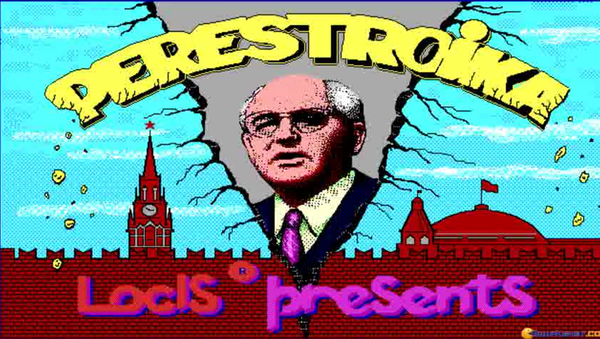Fyodor Shalyapin is singing the old Russian classic “Dubinushka.” On the computer screen there is a portrait of Mikhail Gorbachev in front of the Kremlin walls. Those familiar with early 1990’s PC games will probably recognize that one right away — it’s called Perestroika.
The plot is quite simple: tiny frog has to make its way across the screen, jumping from one shrinking lily pad to another. The game’s symbolism points at the flaking Soviet system, with its changing laws and crumbling infrastructure. According to Nikita Skripkin, one of Perestroika’s co-authors, the game became so popular – one day his friends brought him a copy from across the Atlantic, saying that it’s the way computer games should look like:
“Here, take a look – [they said], that’s how one should write game code. A real hit. Installed almost on all the computers in the US” – says Skripkin.
Perestroika became a lucky ticket for Skripkin and his team. Following the title’s success in 1991 they established Nikita – the first Russian game company. Since then the developer produced more than 100 original titles and localized 70 games for the Russian market.
The Iron Curtain fell soon after Perestroika’s release, and programmers from all over the former USSR started competing openly with their foreign colleagues.
In the 1990’s and 2000’s most computer games were sold as boxed CD’s and DVD’s. They were retailed mostly in specialized stores, and developers struggled to enter global, or particular national markets, with their income depending largely on the appetites of distributors.
But things started changing rapidly with the introduction of high-speed internet connections, which led to explosive growth of the online market.
Wargaming.net, a small company from Belarus jumped on the bandwagon in 2010 by releasing World of Tanks – a massively multiplayer online roleplaying game dedicated solely to tank battles. The game literally broke into the realm, dominated by the games such as World of Warcraft, with is trolls and elves, by presenting a straightforward concept: tanks, and nothing else.
Surprisingly, millions of players from all over the world joined the game and set the Guinness World Record in 2013 for the most players online simultaneously. On that day 190 thousand tank fans were using the same World of Tanks server located in Moscow.
Wargaming.net turned into a huge international corporation. Its founder and CEO Victor Kisliy said in an interview to PwC YouTube’s channel, that he sees his brainchild as “a very cosmopolitan company”:
We have to cater to our users, we have to have those operational marketing centers in San Francisco, in Paris, in South Korea, in Tokyo, in Singapore, in Belarus, you know – for the Russian market. And you have to employ local people. Also our production spans from Sydney all the way across Eastern Europe, little bit of Western Europe, East Coast US, West Coast US – so, that’s it, that’s the whole planet!
Even though you can now see “World of Tanks” bumper stickers almost anywhere – from Sydney, to Moscow to Los Angeles, Wargaming.net is aiming at an even wider range of massive multiplayer online games. With titles like “World of Warships”, “World of Warplanes”, and others, the company, which originated in Belarus and now has its headquarters in Cyprus, is likely to attract millions of new users and, possibly, set even more Guinness World Records.


